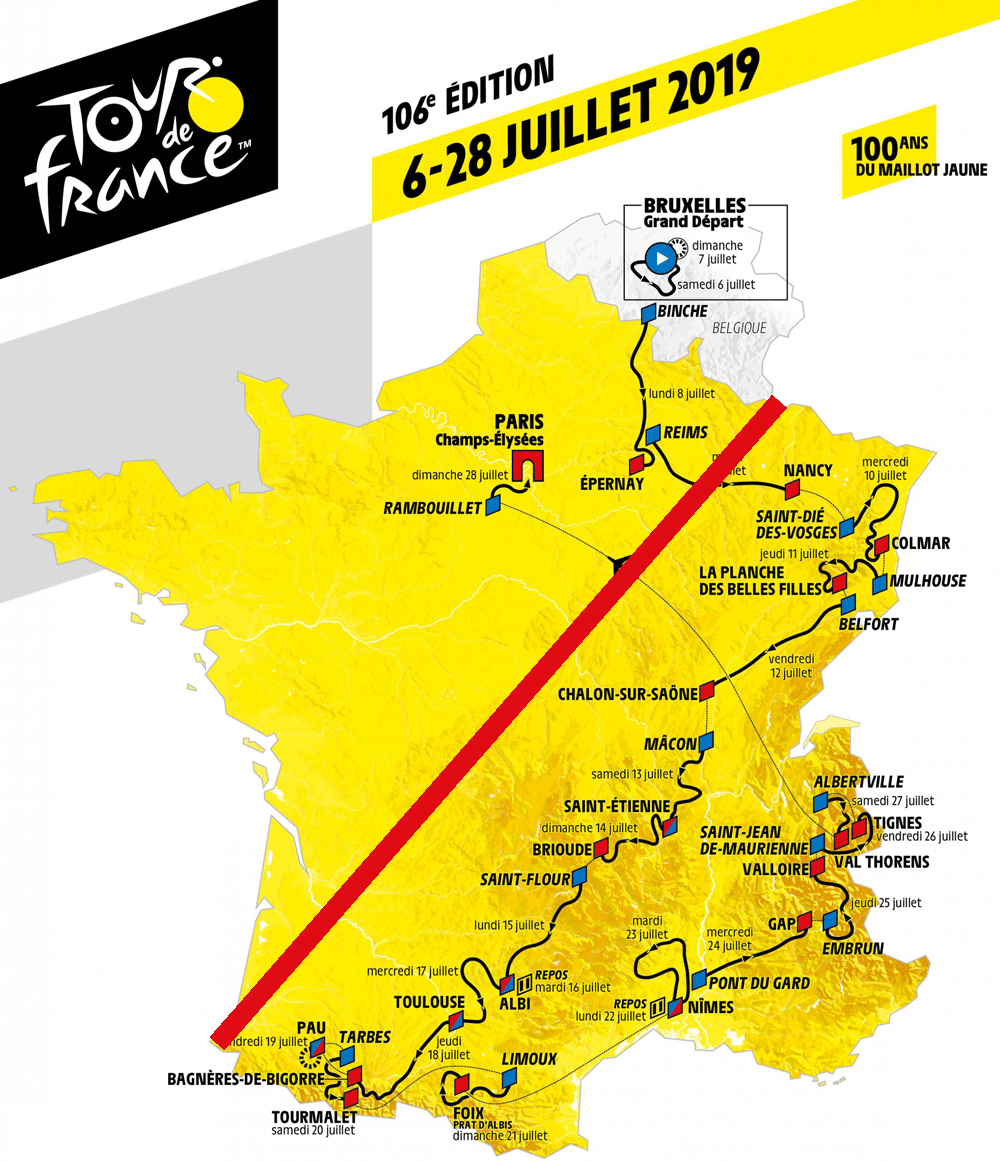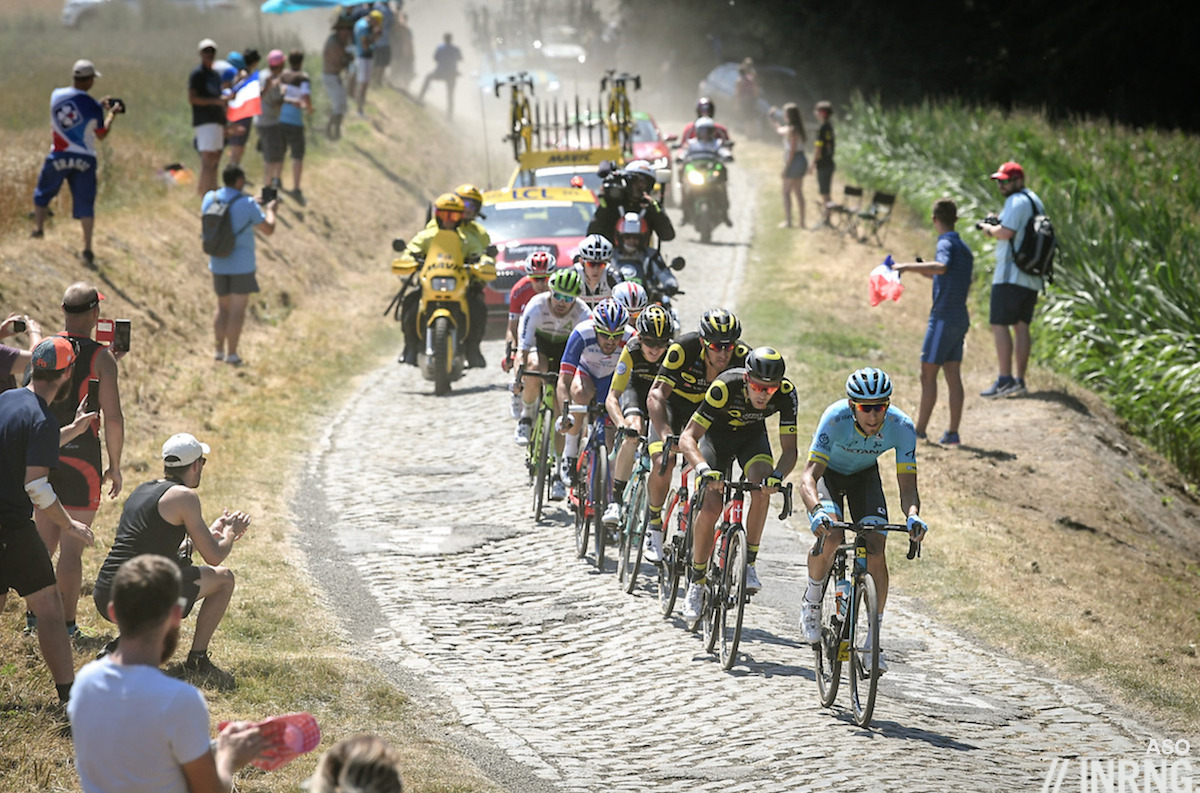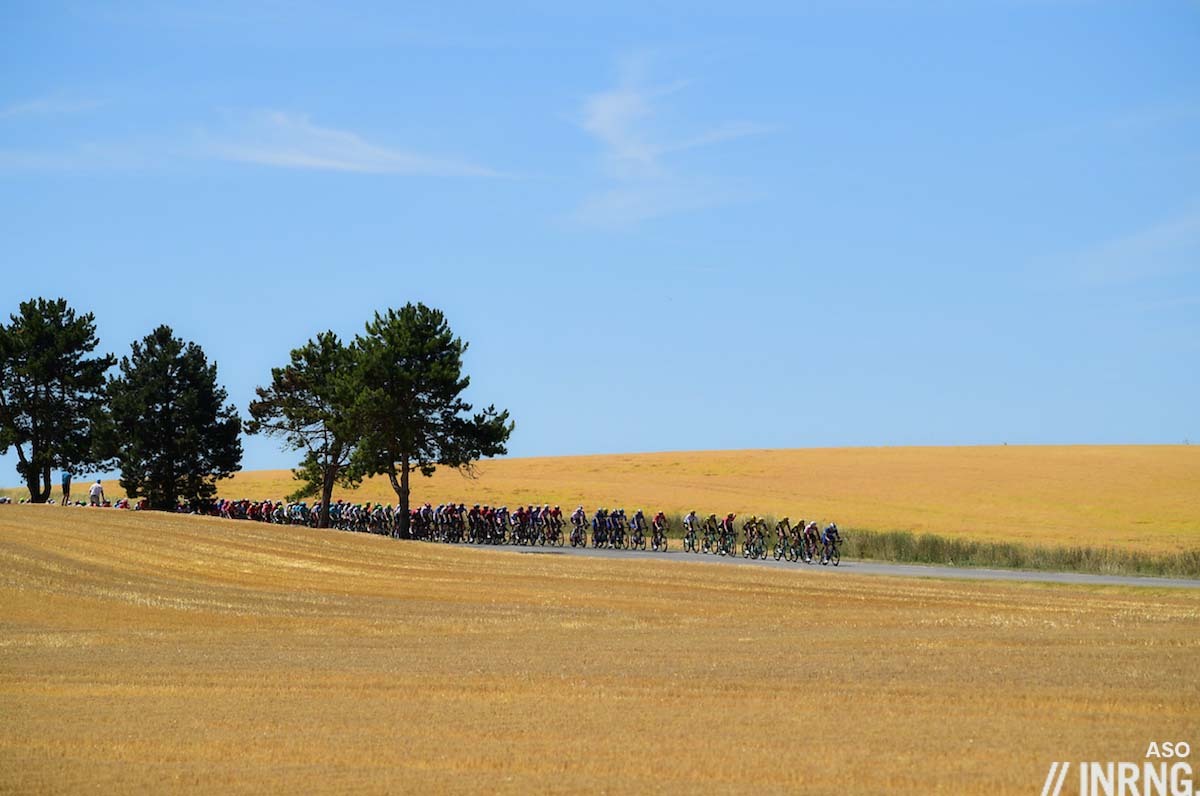The Tour de France continues its procession down the east of France. The race tries to visit as much of the country as possible and each year it’s inevitable that some regions get skipped but there’s a trend now with the race directors searching for the geography needed to make for lively racing and the result is some parts of France are being skipped for years in a row.
France is Europe’s largest country and has a geography to match, from flat plains and marshland to Mont Blanc, Europe’s highest mountain, only the choice bits for a bike race tend to be concentrated. The Alps form the border to the south-east, the Pyrenees to the south, they’re the extremities.

It’s simplistic but the terrain to the right/below the handmade red line on the map above offers the Tour de France varied geography; whereas everything to the left/above offers plain terrain, fields of wheat, cereal and woodland and the dreaded “sprint finish”. There’s nothing wrong with a sprint finish… but there is when we get three in a row. The Tour needs some variety to keep interest in the race going and TV producers weigh heavily on the race design these days, almost every stage needs to have something interesting in the finish to spice things up and if the race doesn’t always come to boil, anticipation of some action still helps.

There are exceptions to the terrain to the north and west and the Tour de France directors work like truffle hounds to sniff out the slightest geographical feature to try and enliven a stage. Think the climb at Mûr-de-Bretagne or the increasing regularity of the Paris-Roubaix cobbles in recent years. But otherwise the difficulty is finding terrain to keep the race varied, it’s not easy. Brittany is a big area for cycling with lots of racing licence holders and regional newspapers like Ouest-France and Le Télégramme that regularly have bike races on the front page which means big crowds but it’s difficult for a multi-day visit. They tried last year to have has many climbs as possible on the stage from Lorient to Quimper but it was a siesta stage that conclused in a sprint among 40 or so riders and Peter Sagan winning. There’s still talk of a Brittany stage with the ribinous, the gravel tracks that define the Tro Bro Leon race and maybe a visit to the Loire valley could also use some of the gravel tracks in the vineyards like they did in Paris-Tours last year; this year’s stage to Epernay did look at gravel tracks amid the vineyards, prompted by the local mayor who is a cycling fan, but race director Thierry Gouvenou found the tarmac climbs hard enough.
Instead this year’s route is new prototype. Long gone is the clockwise or anti-clockwise loop of France, instead it’s now diagonale with the race criss-crossing France in search of variety. Even the sprint stages have their features like yesterday’s climb from Maron out of the Moselle valley 15km from the finish which was a focal point of the stage and there are more to come like this, such as the unmarked climb into Toulouse, a dragstrip final 20km is rare. The Vosges offer hills today and mountains tomorrow and the weekend ahead crosses the Massif Central with hilly roads that should reward attacks and provide uncertainty and suspense.
What to do about the forgotten regions? The Tour de France can’t tour all of France, Christian Prudhomme and colleagues cite a rough policy of visiting each region of France at least once every three years but there are several départments (the 95 administrative areas of mainland France) that haven’t seen the Tour this decade – there’s a handy graphic over at Le Monde – and if you revert to the map with the red line on it most of the area directly above the line are barely visited, it’s sparsely populated and doesn’t have exciting terrain. So the Tour can skip some parts for a surprisingly long time.
Conclusion
The Tour de France can’t tour all of France. The old format of alternating clockwise and anticlockwise loops of France seems long gone and there are some parts of France that are being skipped regularly, even consistently. The Tour can’t stick to the same route every year but the race increasingly has a bias to the east thanks to its geography, the Vosges are an ideal mountain range to complement the Alps and Pyrenees as the race aims for variety. The Planche des Belles Filles has been used three times this decade already and it’s on the route tomorrow and if the races does to to the flatter regions it’s always on the hunt for something to spice things up such as a hill, cobbles and maybe a gravel track for the future. This focus on course design is making the race better. About time.


Interesting points, thanks. Makes me think about F1 and MOTOGP, both competitions where runaway technology (and the resulting speeds) have made many venerable old race courses obsolete or neutered to the point they’re the same in name only. Is this happening to cycling? The advent of superlight bicycles with low, low gears (no matter how you slice it) make the climbs easier, or at least allow the racers to go faster. Radio and power meters also have negative effects, do they affect modern course design? Are these the reasons 1/2 of France seems no longer of use for LeTour?
Next we have the UCI fan survey, which is a big red flag to me as “products” designed as the result of surveys and focus groups too often end up being “everything for everyone” and “nothing for nobody” at the same time. It doesn’t look like another golden age of cycling will be coming around anytime soon 🙁
I’d imagine television, more than anything else, is the main issue here- nothing wrong with a few sprint days in a row in the era where people followed the race in newspapers, but when you’re asking advertisers to spend money on the race, you don’t want several transfer stages ending with sprint finishes in a row.
The UCI fan survey seemed very slanted toward race radios, and banning them, an issue I have mixed feelings towards. In my opinion it needs to be all-or-nothing- either allow race radios or ban them outright, because anything in between will make the sport look silly. Nobody wants a controversy over whether something was a “strategic advice” or not- F1 had this exact issue.
For my part, I mentioned that the biggest issue I had with the sport was the fragmented nature of the broadcasting – I really think the best way to boost one-day races would be to bring back the 10-race World Cup, with a consistent broadcaster, consistent race production, and having these races as a package deal so you don’t have to e.g. subscribe to multiple streaming services to get the ASO, RCS and Flanders Classics races.
They’re working on this idea of a pooled TV resource for the one day races in the World Tour. Working as no news yet, maybe in September at the UCI Worlds?
We know what you mean and thanks for the post really insightful
I agree about the 1 day World Cup but nowadays they’d never be able to settle on 10. Flanders Classics would want about 10 races in alone, you’d need a few in the Middle East to expand the UCI’s bank account, those two in Canada, plus the other 4 Monuments, purists would want Paris-Tours and newbies Strade Bianche (rightly). It would end up the same bloated, incomprehensible mess as it is now, just minus the stage races.
‘France is Europes largest country’
Hi Inrng, let me introduce you to Ukraine – ‘Hi Inrng, I’m Ukraine. I’m the largest country wholly within Europe. You might have heard of my big brother Russia. He’s even bigger than I am and a lot of him is in Europe too’.
Just sayin.
You know what I mean.
Mont Blanc is western Europe’s highest peak too, apparently there are six others higher in Russia and Georgia on the Europe / Asia border.
Pedant corner 😉
Love the pedant “corner corner” addition 😀
Last time I checked France had 668.763 km² and Ukraine 603.700 km² . Yep, oversea territories count. And to be fair, a lot of the Ukraine is not really a part of the state.
Speaking of oversea territories, it would be nice if the Tour would visit one of them some day.
They’ve looked at Guadeloupe and Martinique (the French West Indies) and cycling is popular there, possibly more so than anywhere else in France but logistically it’s too much. Thomas Voeckler – who grew up there for a few years – said it was probably more likely in the days of the supersonic Concorde airliner than it is today.
Stretching this topic a bit…I’m waiting for Vuelta to hit the Canary Islands one day. Long climbs and epic scenery would certainly add a nice cherry on top. But I guess transporting all equipment by airplane is just simply too expensive.
https://en.wikipedia.org/wiki/1988_Vuelta_a_España
Well, if you’re counting overseas territories then Denmark overtakes France for second behind Russia.
But “largest in western Europe” would be correct.
Insightful observations, as always. Maybe ASO can make a virtue of necessity with consecutive sprint stages and make one of them radio-free as a combo of novelty and competitive gesture to put power back in the hands of the riders themselves.
They tried but the teams boycotted it and it made a mess of the stage. But without radios the data show that the peloton just keeps the break on an even tighter leash as it’s more prudent without the ready information.
100% this. Banning radius would make racing more boring. It would be the end of the breakaway.
Not so fast! If this were in any way true, wouldn’t that mean there were no breakaways prior to the introduction of radios? In addition to ditching the radio, the TV’s in the team cars need to go away as well. History has shown that a lot can happen between the time a dangerous group of riders break away and their competitors figure out who they are and where they stand in GC before they decide to chase if left to their own judgement and with limited information. Quite different than these days of instant communication of standings and tactics from directors to riders and vice-versa.
“Fog of War” is often used to describe these situations, which often make for exciting racing. “Radio Tour” is fine to keep control of the race, call up team cars, etc. But ALL of the other electronic gizmos should be banned. ALL of them.
I’ll never understand why a primitive sport like bicycle racing (after all, the things go nowhere unless you pedal them) needs to be “modernized” with all these electronic gizmos and other “improvements”? There’s MOTOGP for two-wheeled technology battles after all.
It’s a bit of a stale subject, there are great races with and without radios and the reverse too but the only actual empirical data on this suggests races without radios are more controlled these days.
Where is this data? What kind of time period does it cover? I don’t know how a real scientific comparison could be made, do you?
And yet the three best stages of this year’s Paris-Nice were above the red line?
And they provided far more GC movement than has been the case in the hillier terrain of the past two days.
Be careful what you wish for if theTour is going to go haphazardly seeking hills.
You’ll end up with super teams full of Kwiatkowski – type riders who shepherd their GC men around the dales and vales with next to no GC race to speak of until the TT / high mountains.
The peloton will adapt to what’s put in front of it.
Good point but only if the wind blows… it can in March but it’s much more rare in July. The 2013 Tour had a stage from Tours to Saint Amand Montrond which on paper looked the most boring stage of the entire race but it was windy and was a vintage day of action. Cavendish won ahead of Sagan… and Mollema as a small group reached the finish.
As a national event of cultural importance, I may feel aggrieved if I was a citizen and cycling fan of a department that the Tour rarely visits.
Significant public funds go towards the race and, whilst some of this may be via local taxation, there is presumably central funds being awarded too and it doesn’t seem right that whole tracts of the country are being missed or, worse, deliberately avoided?
I’d feel aggrieved too. With tour starts in the UK, Belgium, Holland etc., at the expense of many French departments, the ASO clearly prioritises commercial criteria ahead of some proportion of France’s population.
these “foreign areas” loved their tour starts so much that you also can see it as gesture towards good neighborhood, or as export of “soft power” if you want to see it politically. surely in the interest of “la grande nation”
It seems as well the complaints about long transfers have been heard: there’s been fewer and fewer, but this also contributes to the race being condensed in one area
Some great analysis here of the stage distances etc: https://www.kaggle.com/jaminliu/a-brief-tour-of-tour-de-france-in-numbers
Got me wondering how well a 300km would be received nowadays. Would certainly help with covering more ground!
Personally I prefer the “boring” sprint stages to one like today. It was very scenic with lots of villages and small towns with their bands and displays. An awful lot of castles too. However the main point is racing. The climbs were too hard for the sprinters but not hard enough for the GC players to put in any real effort. The flat run in meant that there were very few possible winners, either have a longer flat run in after the climbs so more sprinters get back in or have the finish close to the bottom of the downhill section to
Thanks, as usual, for your commentary. Never dull, and even a committed francophile/francophone like me can always learn something new.
I’ve been staring at that red line across the Hexagon thinking ‘I know that’, and yes, it’s the Empty Diagonal, the most deserted, most hopeless parts of France. Not even a cycle race will go there. There’s an excellent set of photos and accompanying essay on the Magnum website covering this topic, incidentally.
As the Tour is really an advertisement to entice visitors to France, and to show off the nation’s regions to other French folk, I think the organisers are fulfilling their remit. If I can’t watch a wild GC battle every day, I’ll settle for some nice vineyards and castles instead. The weird belief that all sport has to be intensely exciting at all times must be mystifying to professional athletes. For them it’s a job, and no one enjoys every moment of their job. No highs without lows etc.